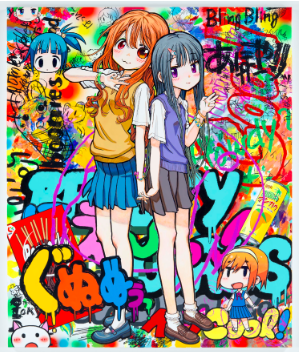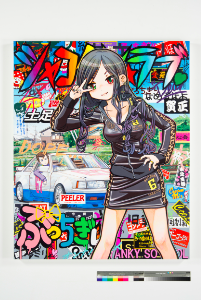ABOUT STOP PRESS
Stop Press is ISBN Magazine’s guide to happenings in Hong Kong. From art to auctions and from food to fashion, to entertainment, cinema, sport, wine and design, scroll through the best of the city's dynamic cultural offerings. And if your event merits mention in our little book of lifestyle chic, write to us at stoppress@isbn-magazine.com
Loliconography

Against which backdrop arrives Sweeet!, 44-year-old Mr.'s art specially created for Galerie Perrotin. Standing in the white-walled gallery observing these poster-sized glossy controversial confections of voyeurism and fetish, hurry-scurry with multiple mo(e)tifs promoting cute and kink - young girls almost like dreamy pets - it's hard to reconcile as art, and can seem like tacky grotesquerie; a gallery of pre-teen fandom stuck on a bedroom wall, the busied paint-splattered canvases like premature ejaculations or the pre-pubescent wet dreams of a sensibility that never grows up. It isn't saucy, just saucer-eyed.
Mr. paints things he is ashamed of. He is a 'lolicon', a term derived from Vladimir Nabokov’s protagonist Humbert Humbert who bears the ‘Lolita complex’, and projects his dark, obsessive and presumably doomed desire through his moe girls. This time around, he has incorporated elements of Western art, sort of Banksy-san, with graffiti-esque patterns familiar to a wider audience. But if the subject matter shames the artist, how should the viewer feel? Do we berate the artist, how 'lo-moe' can he go, or do we just indulge the cartoon or comic Pop and some of its undeniable wit and fun, as though viewing a version of Roy Lichtenstein's splashy canvases, and ignore the parental guidance rating?
Iwamoto is a big name in Japanese art, who matured under the even bigger shadow of Takashi Murakami. After graduating from the Department of Fine Arts, Sokei Art School in Tokyo in 1996, he became Murakami's assistant, and founding member of Murakami's Kaikai Kiki company, a Japanese equivalent of Andy Warhol's Factory in New York. Iwamoto has been associated with the Superflat art movement - which explores the emptiness of Japan's post-war consumer culture and sexual fetishism, where distinctions between high and low art dissolve at the door.

But we're still left with a paradox: On the surface these confections are contagious, candy flossy, highly cultured Pocky-sweet pop, yet, below, like the ever-present references to planetary opposites Jupiter and Saturn in the paintings, we feel Jupiter law-abiding, honourable, and Saturn, licentious, one step away from restraint. Such explicitly vibrant work, harbours a mordant subtext; Mr.'s impossible love, a dark desire that cannot speak its name but can show its lot in supra-luminous paint. And standing four feet ten in one sock, it's worth a look.
"Sweeet!" at Galerie Perrotin, 17/F, 50 Connaught Road, Central, Hong Kong. Tues-Sat: 11am - 8pm. Until November 9.
Images: High School Story - Satsuki-tan & Miyabi-kyun Favorite (194cm x 162cm); and Shakotan Love: Virgin Blue (162cm x 130cm); ©2013 Mr./Kaikai Kiki Co., Ltd. All Rights Reserved. Courtesy Galerie Perrotin
Loliconography

Against which backdrop arrives Sweeet!, 44-year-old Mr.'s art specially created for Galerie Perrotin. Standing in the white-walled gallery observing these poster-sized glossy controversial confections of voyeurism and fetish, hurry-scurry with multiple mo(e)tifs promoting cute and kink - young girls almost like dreamy pets - it's hard to reconcile as art, and can seem like tacky grotesquerie; a gallery of pre-teen fandom stuck on a bedroom wall, the busied paint-splattered canvases like premature ejaculations or the pre-pubescent wet dreams of a sensibility that never grows up. It isn't saucy, just saucer-eyed.
Mr. paints things he is ashamed of. He is a 'lolicon', a term derived from Vladimir Nabokov’s protagonist Humbert Humbert who bears the ‘Lolita complex’, and projects his dark, obsessive and presumably doomed desire through his moe girls. This time around, he has incorporated elements of Western art, sort of Banksy-san, with graffiti-esque patterns familiar to a wider audience. But if the subject matter shames the artist, how should the viewer feel? Do we berate the artist, how 'lo-moe' can he go, or do we just indulge the cartoon or comic Pop and some of its undeniable wit and fun, as though viewing a version of Roy Lichtenstein's splashy canvases, and ignore the parental guidance rating?
Iwamoto is a big name in Japanese art, who matured under the even bigger shadow of Takashi Murakami. After graduating from the Department of Fine Arts, Sokei Art School in Tokyo in 1996, he became Murakami's assistant, and founding member of Murakami's Kaikai Kiki company, a Japanese equivalent of Andy Warhol's Factory in New York. Iwamoto has been associated with the Superflat art movement - which explores the emptiness of Japan's post-war consumer culture and sexual fetishism, where distinctions between high and low art dissolve at the door.

But we're still left with a paradox: On the surface these confections are contagious, candy flossy, highly cultured Pocky-sweet pop, yet, below, like the ever-present references to planetary opposites Jupiter and Saturn in the paintings, we feel Jupiter law-abiding, honourable, and Saturn, licentious, one step away from restraint. Such explicitly vibrant work, harbours a mordant subtext; Mr.'s impossible love, a dark desire that cannot speak its name but can show its lot in supra-luminous paint. And standing four feet ten in one sock, it's worth a look.
"Sweeet!" at Galerie Perrotin, 17/F, 50 Connaught Road, Central, Hong Kong. Tues-Sat: 11am - 8pm. Until November 9.
Images: High School Story - Satsuki-tan & Miyabi-kyun Favorite (194cm x 162cm); and Shakotan Love: Virgin Blue (162cm x 130cm); ©2013 Mr./Kaikai Kiki Co., Ltd. All Rights Reserved. Courtesy Galerie Perrotin
